|
|
Blacklock

|
|
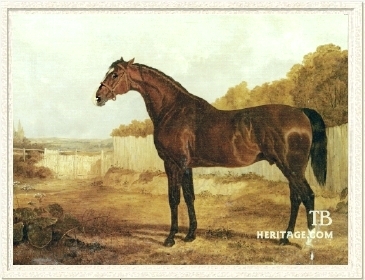 |
|
|
Blacklock was a plain-headed, calf-kneed, upright son of a horse that won some very small races in the north over few opponents. Blacklock proved to be a very good race horse of great stamina and soundness who sired enough winners to propel him to the top of the leading sires in England in 1829, and got a son who continued the King Fergus sire line, leading, five tail-male generations and three classic winning colts later, to St. Simon, the most influential sire of the late 19th century.
Blacklock's sire, Whitelock, was a stayer who ran in North Country courses. He was by the great race horse Hambletonian, who won all but one of his twenty matches and races, including the St. Leger and the Doncaster Cup (twice); Hambletonian also sired the grey Doncaster Cup winner Camillus (1803), a fairly successful sire of such horses as Minna Dalby, Magistrate, Minister, Treasure (an influential broodmare), Consul (Doncaster Cup), and Oiseau (later sire of St. Leger winner Rowton). Another Hambletonian son was Ascot Gold Cup winner Anticipation (1812). According to The Druid, Whitelock was a "naggish sort of horse, with a big coarse head and plump [plumb, as in upright] forelegs." A bay, he raced unnamed in his first race at the age of six, and finally was dubbed "Whitelock" by his then-owner, Sir Mark Sykes, due to a splash of white hairs in his tail. He was out of the chestnut Phoenomenon mare Rosalind, whose dam, Atalanta was a good race mare by Matchem, and was bred by long-time Yorkshire breeder William Garforth at Wiganthorpe, who also bred Camillus, and who bred four Doncaster Cup winners in a little over thirty years.
Whitelock, unnamed at the time, ran for Garforth, unplaced, in the City Purse at York in 1807, and the following year ran third in a maiden plate at Malton, after which he was sold to (later Sir) Tatton Sykes of Sledmere, Yorkshire. Sykes rode him himself in a Hunter Stakes of 10 guineas each over four miles at Durham, beating his sole opponent, and the following day Whitelock won a maiden plate in four two-mile heats . Sykes also rode him in the three mile Macaroni Stakes at Pontefract, carrying the heavy weight of 12 st. 10 lbs, where he beat two other horses. He went on in the fall to win £50 in four three-mile heats at Northallerton, and then ran second in a race of two-mile heats. The next year, 1810, carrying the name Whitelock, he ran for Tatton Sykes' elder brother, Sir Mark M. Sykes. He ran twice at Knutsford, dead-heating for the Gold Cup, which he lost in the deciding heat; the following day he won a £60 plate in two four-mile heats, and was then retired from the turf.
Although Whitelock had shown he could go a distance and carry weight, with his extremely indifferent race record he was not deemed good enough for the Sledmere stud, and was sold to Sylvester Reed for 300 guineas. He was used as a country stallion, travelling through the area around York. In 1813 he was put to a mare by Coriander (1799, out of the Highflyer daughter Wildgoose), who had been purchased by York horse-dealer Francis Moss at the York horse market for £3 in 1803. The resulting dark bay-brown foal of 1814, Blacklock, had his sire's Roman-nosed head --"a head like a half-moon" -- and also inherited his vertical pasterns; he was also calf-kneed. Moss offered him to Reed when Blacklock was a yearling, but Reed wasn't interested. Another York horse dealer, Thomas Kirby, purchased him for £40. Kirby was a more successful dealer who brokered the sale of many horses both in England and on the Continent; on occasion he chartered ships to take horses he had bought for Russian investors to that country, engaging in that trade for almost 40 years. He sold Blacklock at age two, to Richard Watt of Bishop Burton, near Beverely, in Yorkshire, the owner of the great broodmare Mandane, who produced two classic winning fillies for him, and the good racehorse and sire, Lottery (all by Tramp), in addition to Blacklock's good sons Brutandorf, Belzoni and Belshazzar. Moss' £3 Coriander mare produced the St. Leger winner Theodore (1819), by Woful, five years after Blacklock was born.
Although he wasn't pretty, Blacklock proved to be a horse of great stoutness and soundness. He had a "muscular" neck, which with maturity would become cresty, a deep shoulder and a deep girth, and hocks which "stood well away," requiring "great strength in loin to support." These were all traits he often passed on to his offspring, and they to theirs.
Blacklock on the Turf
Blacklock was a true distance horse, with a huge stride, "requiring a half-mile to settle it." In the St. Leger, Watt's trainer Tommy Sykes instructed jockey John Jackson to "Ride him as thou lik'st, only lay thee hands down, and let him stride along, and he'll distance the lot." He won over 2,525 guineas, in addition to his Gold Cup and plates, a good sum for that time.
Blacklock ran twice at the age of two. He won 80 guineas at Pontefract for Kirby, beating three other horses, and then, at Doncaster, running for Watt, he won 200 guineas, beating Cameleon, Angelica, and four others.
In 1817, he ran second to Ebor in the Doncaster St. Leger, in a field of nineteen; Blacklock had a three length lead at the distance post, when Sykes called to John Jackson, to steady him, "thou hast it all thy own way," a command also heard by Ebor's jockey, who fell into Blacklock's blind spot, and spurted past him at the post to win by a head. While Sykes was enraged by Jackson's riding, and eventually succeeded in having him dismissed from Watt's service, it was Sykes' call, "pull till'em" that cost Blacklock the win. Three days after the St. Leger, Blacklock won the Gascoigne Stakes there, but ran second to the heavier-weighted, year-older The Duchess (winner of the 1816 St. Leger) in the Club Stakes. In October, at Richmond, he won two races, including the Dundas Stakes.
At age four, in 1818, he won a race at York spring, beating Rasping, who later won the Doncaster Cup. At York in August he won the four mile Great Subscription Purse, and the second (two mile) Great Subscription Purse, and following that race, on the same day, beat Rasping and three others in a 250 guineas race. At Doncaster, he won the four mile Doncaster Stakes, again beating Rasping, and the Club Stakes, beating Duchess, who had bested him the year before in that race. At Richmond, in October, he won the Dundas Stakes for the second time, but ran fourth and last for the Richmond Cup, won by Dr. Syntax.
In 1819 he ran second in a sweep for 130 guineas at York spring meeting, then went on to win the York Cup. At York in August he won the four mile Great Subscription Purse, a hard race in which he beat Magistrate (by Camillus) by a short head; Magistrate was retired from the turf after this race, and Blacklock, who ran second in the second (two miles) Great Subscription Purse the next day, broke down, was also retired, to start his stud career at Watt's Bishop Burton stud, displacing Tramp, who was sold on.
Blacklock in the Stud
Blacklock's initial stud fee at Bishop Burton was 15 guineas -- a high fee at the time matched by such horses as Comus, Whisker, Woful and Filho-da-Puta and exceeded only by Soothsayer at 25 guineas and Rubens at 20 guines. But despite his successes on the turf, breeders were leery of his forelegs, and Watt leased him to Thomas Kirby at York for £100 per season for four seasons. He covered at a much less exalted fee at Booklesess's in Dringhouse, York at 8 guineas in 1820, and at 8-1/2 guineas at Beverely the folowing year, and in 1822 at Kirby's stables near York he covered at 7-1/2 guineas in 1820, his fee rising to 10 guineas in 1823-24. Watt then sent him to stand at Christopher Wilson's Ledston Hall, Ferrybridge, for a season, at 12 guineas, and then to Biddleston, Suffolk. Back in Beverely in 1827, he was lodged at The Rose and Crown tavern, where his fee was 20 guineas. In 1828 he was brought back to Bishop Burton, where he stayed until his abrupt death in the spring of 1831, his fee as high as 25 sovereigns. He died February 24, 1831, at the age of 17, having ruptured a blood vessel, after covering a mare named Laura. He was buried at Bishop Burton; his bones were later exhumed and his skeleton was displayed in the harness room at Bishop Burton for many years.
Blacklock was a successful stallion who got over seventy winners of 442 races, most of them on North Country courses; one figure put the total earnings of his offspring at over £50,000, including 49 gold cups and numerous king's plates. He was leading sire in England in 1829, the year of Voltaire's Doncaster Cup victory, and also the year that Velocipede won the Gold Cups at York and Liverpool, Laurel won two cups, and Robin Hood won some big races in the north. Not a one of his offspring was ever a classic winner -- although several came close -- but three of his sons produced classic winners, Belshazzar siring one, Velocipede siring three, and Voltaire siring two, and the latter got Voltigeur, from whom St. Simon descended in tail-male. Some of Blacklock's daughters and those of his sons, were good producers, and many more became key links in various female lines that eventually produced top runners and sires. |
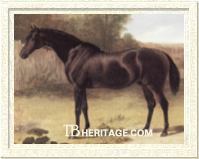
Voltaire
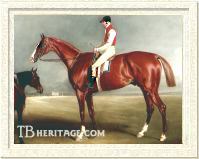
Velocipede
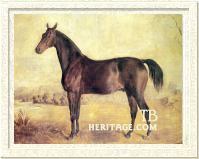
Tranby.
| |
VOLTAIRE (1826) was the son who carried on this branch of the King Fergus sire line, from which emerged the great late 19th century sire, St. Simon. Voltaire was bred by Robert Stephenson of Hart, Hartlepool, who later bred his dual-classic winning son, Voltigeur. Voltaire's dam was a mare by Phantom, and Voltaire was by far her best of fifteen live foals. He was a big horse, and his head was more refined than that of his sire's and most of Blacklock's offspring. He only spent two years on the turf, running second in the St. Leger and winning the Doncaster Cup, before retiring to the stud, where he sired two classic-winning sons, one of which, Voltigeur, carried on the sire line.
The blaze-faced chestnut VELOCIPEDE was born in 1825 near York. He was bred by Francis Moss, who also bred his siblings Malek, Merope, and Moss Rose. His dam, an 1817 mare by Juniper, out of a Sorcerer daughter, was barely 15 hands tall; she produced sixteen foals between 1821 and 1841 (Merope, by Voltaire, being her last), over half of them by Blacklock, and most of them were winners on north country courses. Velocipede had his sire's Roman nose, deep girth, and well-muscled neck, but unlike most Blacklock progeny, he was light-boned and tall. At some point during his career he developed a "knot" on his foreleg, which periodically aggravated a tendon, earning him the sobriquet "the magnificent cripple." He won the St. Leger Stakes at York, the two-mile York Gold Cup, the Liverpool Cup over two miles, and several other races, and after retirement to stud, sired three classic winners, the best being his dual-classic winning daughter, Queen of Trumps, and some good distance horses, including Goodwood Cup winner Hornsea. None of his sons were able to get a sire son of use.
TRANBY (1825) was out of a mare by Orville, and was initially owned by the gambler Robert Ridsdale. His half-sister, Wagtail, by Prime Minister, born in 1818, became the dam of Blacklock's son, LAUREL. Tranby ran under the ownership of Ridsdale's one-time associate, John Gully, and was just moderately successful on the turf, running third in the Brighton Stakes in 1830, and winning the Oatlands handicap at Newmarket Craven in 1832. In 1831 Gully loaned him to the professional sportsman Squire George Osbaldeston, who wagered £1,000 with Colonel Charettie that he could ride 200 miles in less than ten hours, using any number of horses he wished. This famous "match against time" took place at Newmarket's Houghton Meeting in four mile laps on November 5.
|
Gully, a notorious gambler, was offered 10-1 against the ride taking place within nine hours, and Tranby was loaned to ensure Osbaldeston would win. Osbaldeston won the bet by taking eight hours, 42 minutes to cover the milage on 29 horses, the fastest of which was Tranby, who was ridden four times in the four-mile laps (16 miles total); his second lap was run in eight minutes flat.
In England, Tranby sired a moderately good cup horse, I-Am-Not-Aware. Tranby was sold to America and imported by Merritt & Co. of Hicks Ford, Virginia, in 1835. He was one of eighteen stallions purchased on speculation by Dr. A.T.B. Merritt and his two brothers between 1832 and 1837 to sell to American breeders. In 1836 Tranby was sold on to Robert Gilmore of Baltimore, Maryland. He was a moderately successful sire of 28 winners of 52 races between 1839 and 1846, most of which showed they could go a distance and carry weight. In Kentucky, he sired a daughter, foaled in 1844, that became the dam of the good racehorse and top sire Vandal (1850, by Glencoe), who got four great producers -- Ella D., Vandalite, Capitola (dam of King Alfonso) and Mollie Jackson -- and Virgil, the sire of Hindoo. She was also the dam of the good gelding Alaric (1842, by Mirabeau), Levity (1845, by Trustee), who became one of the great American broodmares, ancestress of Luke Blackburn, The Bard, and many other American winners. |
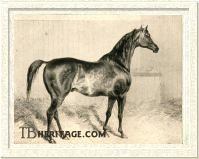
Laurel
| |
The brown LAUREL (1824) was born at Heslington Hall, near York, bred by Major Nicholas Yarburgh from Wagtail, who was also bred by the Major. Wagtail was by Prime Minister, a half-sister to Tranby. Laurel was a brother to BELINDA, who ran second in the Doncaster St. Leger, and a half-brother to St. Leger winner Charles XII. He became a great Cup horse, and ran until to the age of seven.
He ran twice at the age of three, not placing in the York St. Leger, and running "a bad third" to Matilda in the Doncaster St. Leger. | |
At age four Laurel he was undefeated: he won the Constitution Stakes at York, beating Matilda and Mulatto; the Beverley Gold Cup, beating Lady Georgiana; the Pontefract Gold Cup (2-1/4 miles), beating four others; the Doncaster Cup, beating the good horse Longwaist by a neck, with the field also including Mameluke, and two others.
At age five, he won the Stand Cup at Liverpool, beating the good horse Halston; the Preston Cup, beating two other horses; a race at Doncaster, beating Moonshine. He was bested by other Blacklock sons in some of his other races that year: he ran second to VELOCIPEDE for the York Cup (2 miles), and was second to him again in the Doncaster Cup; he was also second to ROBIN HOOD in the Beverley Gold Cup, and also ran second to the great, long-running mare Fleur-de-Lis in the Great Falconer's Cup at Lincoln.
In 1830, age six, he won the York Gold Cup, beating the good Whisker filly, Maria by half a length; the Pontefract Cup, beating two others, a race at Doncaster, beating the Tramp filly Ballad Singer and three others, and a race at Lincoln. At York spring meeting, he ran third and last in the Constitution Stakes, won by Medoro, and at York in August, he ran second for a Silver Tureen and sweepstakes to the Lincoln course specialist, Fortitude. He did not place in his only other race, the Doncaster Cup, which was won by Retriever, who had won the Doncaster St. Leger the previous year.
In 1831 he won the Beverley Gold Cup again, his only victory that year. He ran second to Maria in the York Gold Cup, and also ran second to her in the Doncaster Stakes (2 miles) later in the season. In his other two races that year he ran third: he was third and last for the Silver Tureen and sweepstakes at York August (won by Maria), and also third in a race at Doncaster over four miles, his last race.
He was sold to William Theobald, and entered his Stockwell Stud, in Surrey. He wasn't particularly successful as a sire, however one especially in-bred, unnamed daughter (1840, from Flight by VELOCIPEDE (by Blacklock), Family 8 -f) was the dam of two Oaks winners: Rhedycina (1847) and Governess (1855, who also won the 1,000 Guineas). These mares both bred on, Rhedycina becoming second dam of the dual-winning Grand National Steeplechase horse Manifesto (1888). Their sister, The British Queen (1845), was tail-female ancestress of a slew of top winners, including top American sire and stakes winner Blue Larkspur, Relic, English classic winner Cheveley Princess and Australian racehorse and sire Manikato. Some good stakes winners also emerged from the female line of Laurel's daughter, Westeria (1835, out of Monimia, Family 12 - c). |
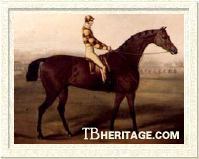
Brutandorf
| |
The great producer Mandane, in Richard Watt's Bishop Burton stud, was the dam of BRUTANDORF, in Blacklock's first crop of 1821. He won the Sapling Stakes at age three, and at age five won the Chester Cup, beating nine horses, and two days later won the Stand Cup at Chester, beating some good horses, and also won the Tradesmen's Cup that year. In the stud he was very successful, and until the 1860s it seemed as if the sire line would flourish through him, but it eventually fizzled out, where the Voltaire line gained in prominence. | |
BRUTANDORF got Hetman Platoff, a great cup horse whose wins included the Liverpool St. Leger, the Kelso Cup, Ayr Gold Cup, Woverhampton Cup and a number of other races. Hetman Platoff sired some good stakes winners who ran in top company. Another Brutandorf son was Physician, winner of the Scarborough Stakes and the Gold Cup at Northallerton at age three, and the Manchester Cup, the Croxteth Stakes and other races at age four. Physician was also a decent sire, who got Grand National Steeplechase winner Cure-All; Champagne Stakes winner The Cure, who later sired the fast stayer Underhand, French Derby winner Experience, and Grand Prix Nacional (later Prix Gladiateur) winner Dulcamara, as well as the jumping mare Jealousy, who won the 1861 Grand National Steeplechase. BRUTANDORF also got a Grand National winner, the gelded Gay Lad (1834). In all, five winners of the Grand National descended from Brutandorf within four generations.
Mandane's Oaks-winning daughter, Manuella (1809 by Dick Andrews), also in Watt's Yorkshire stud, produced two good colts to Blacklock: BELZONI (1823), AND BELSHAZZAR (1830). The brown Belzoni (1823) won the York St. Leger and in the stud became a noted sire of hunters: he sired Vanguard, who won the 1843 Grand National Steeplechase. Belshazaar was an erratic racehorse who ran in top company and won the Two Year Old Sweepstakes at Doncaster; in the stud he sired 1,000 Guineas winner Cara and some other good horses, including Miss Lydia, the dam of the influential broodmare, Maid of Masham, and was imported into the U.S. by Flintoff & Anderson of Nashville, Tennessee, in 1838, where he became an influential sire.
Other Blacklock sons who did well on the turf included MALEK (1824), a brother to VELOCIPEDE and to MOSS ROSE, from the Juniper mare. He was a distance horse who ran in the north. He ran third to Blacklock's son ROBIN HOOD in the two mile Newcastle Gold Cup, and third to Tarrare and Medoro in a two mile sweepstakes at York, and ran second to Actaeon in the Caledonian Hunt's four-mile King's Guineas. ROBIN HOOD (1824), from the Tramp daughter Marion (1819), a sister to Barefoot, was a good distance horse; at age four he won the two mile Newcastle Gold Cup and also Newcastle's Corporation Cup, and at age five won the Newcastle Gold Cup, the Durham Gold Cup, the Beverley Cup, and was second to the great stayer Bessy Bedlam in the Lincoln Gold Cup. Another good Blacklock Cup winner was PELION (1825), who won the Lancashire Stakes, and the Gold Cups at Braxton and Oswestry.
The bay POPSY (1824) won a sweepstakes for two year olds at York, and later ran second to Actaeon in the 1827 Richmond Gold Cup and second to Lady Georgina in York's Great Subscription Purse. WHITEBOY (1825) won the Dinner Stakes at Newmarket Craven; TAMBOFF (1826) won Doncaster's Cleveland Stakes; STREATHAM won a sweepstakes at York; SAMARCAND (1830) was a "good honest horse" who ran third in the 1834 Ascot Gold Cup (won by Glaucus); CRESCENT (1827) won the Somersetshire Stakes at Bath, beating Mazeppa; ACIS (1827) took Newmarket's Woodcote Stakes; BUZZARD (1821) won a sweep at York in 1825, beating Actaeon; BRYAN (1827) ran second the Glocestershire Stakes at age four; BROWNLOCK won a sweep at York in 1825, and a King's Plate at Newmarket First Spring in 1828, and ran second to Chateau Margeaux in a four mile King's Plate at Ascot in 1828, and also placed second that year in two mile heats at Abingdon; CROWCATCHER (1822), so-named because a stud groom and trainer at Lord Strathmore's stud "had seen him deftly behead a wool-stealer, ipso facto," ran second to Barefoot in the 1826 Lancaster Cup, second to Longwaist in the 1827 Lancaster Cup, and second to Memnon in the York St. Leger of 1825, among his numerous placings.
Blacklock's Daughters
Blacklock's daughters were not big winners on the turf. MOSS ROSE (1827), a sister to VELOCIPEDE and MALEK, and half-sister to Merope, was a good north country racer, winning the Liverpool St. Leger and Chester's Dee Stakes, and running second to Walton in the Liverpool Stand Cup in 1831. BELINDA (1825), a sister to Laurel and half-sister to Charles XII, ran second to The Colonel in the Doncaster St. Leger. LOCKET (1825) ran in good company, coming second to Bessy Bedlam in a race at Beverley at age two, and third to her that same year in a race at Doncaster for two year olds; at age four she ran second to Jenkins in the Oatlands handicap at Newmarket, and third in a 100 sovereign race won by Mameluke at Newmarket. FLUSH (1825) ran second to Trampoline (Glencoe's dam) in a race at Newmarket for three year old fillies. EMMELINA (1825), REDLOCK (1823), ROSETTA (1826), MISS PRATT (1825), and LUNACY (1824), all ran and placed in races in the north.
Blacklock's daughters were also a modest lot as broodmares, although they produced a number of winners of north country races, and many had descendants in tail-female who would emerge five or more generations later with a classic or top stakes winner.
|
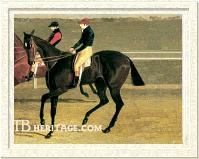
Belinda ran second in the 1828 St. Leger
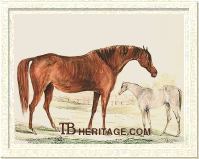
La Danseuse and daughter Reel
| |
Of those more immediately successful, one was BELINDA (1825), the sister to LAUREL and half-sister to St. Leger winner Charles XII, out of the Prime Minister mare Wagtail. She herself was good enough to run second to The Colonel in the Doncaster St. Leger for her owner, Major Nicholas Yarburgh, and she eventually retired to his stud at Heslington Hall, near York. She produced a number of foals, her best being Tuscan (1846, by Lanercost), who won the Gimcrack Stakes; The Doctor (1834, by Dr. Syntax) who won the Croxteth Stakes and was a good Cup horse, and the in-bred black Lollypop (1836, by Voltaire), the dam of the good racehorse and sire Sweetmeat, who is a key link in the Byerley Turk sire line. The American horses Hastings and Plaudit descend tail-female from Lollypop, and Exceller, Broad Brush and Le Ksar have Belinda as a tail-female ancestress.
LA DANSEUSE (1828, out of Madame Saqui (half-sister to Chester Cup winner Fylde), by Remembrancer) won three races: a sweepstakes at Chester at age three, a sweepstakes at Manchester, and a sweepstakes at Liverpool. In the Hampton Court Stud she produced Reel (1836, by Camel), and from this single thread descends all of Family 13 - e, a successful female line of stakes winners on all continents. |
Another Blacklock daughter, HELEN (from Helena by Rubens), was the dam of Chester Cup winner St. Lawrence (1837, by Skylark. MOSS ROSE, who won the Liverpool St. Leger, produced the Nassau Stakes winner Rosa Bianca (1837, by Augustus). Moss Rose was out of the Juniper mare who was the dam of Malek and Velocipede; another sister, ENERGY, became second dam of Gontran (1862), who won the Prix du Jockey Club and the French 2,000 Guineas. SHIRINE (1828, from Young Rhoda by Walton) produced the Prix du Cadran winner Liverpool, by Liverpool. EMMELINA (1825, out of Agatha, by Orville), was the dam of Madeline (1840, by Glaucus), who won the Union Rennen in Germany.
Several Blacklock daughters were second dams, in tail-female descent, of some good horses. VERSATILITY (1825, from Arabella by Williamson's Ditto), was second dam of Ascot Gold Cup winner Asteroid (by Stockwell); an 1824 unnamed daughter of Blacklock out of Hornsea's dam by Cerebus, was the second dam of the good race filly Miss Elis, who won the Goodwood Cup and other races; another unnamed Blacklock daughter who was half-sister to St. Leger winner Jerry (out of Louisa, by Orville), was second dam of the Grand National Steeplechase winner Free Trader (1849, by The Sea). MISS PRATT (1825, from Gadabout by Orville) was the dam of Echidna (1838, by Economist), a great producer important in Family 24, who was the dam of St. Leger winner The Baron (1842, by Birdcatcher) and the good race filly Citron (1853, by Sweetmeat). Another Blacklock daughter, NELL (1831, from Madame Vestris by Comus), was the second dam of Mrs. Ridgway (dam of dual Doncaster Cup winner, the in-bred Vedette (son of Voltigeur, by Voltaire), and his sister Qui Vive, who is so important in Family 19-b).
Blacklock in Jumper Pedigrees
Blacklock's sturdy blood was seen in the pedigrees of many hunters and steeplechasers; eleven winners of the Grand National Steeplechase at Aintree descended from him within six generations. While six descended from his cross with the great broodmare Mandane and her daughter Manuella, which produced the sons Brutandorf and Belzoni, respectively, five others came from other female lines. |
In addition to those listed on the chart, Blacklock was in the pedigree of the 1882 Grand National winner, Seaman, through his dam, and of the 1877 winner of the National, Austerlitz, also through his dam.
-- by Patricia Erigero
|
|
|
|

